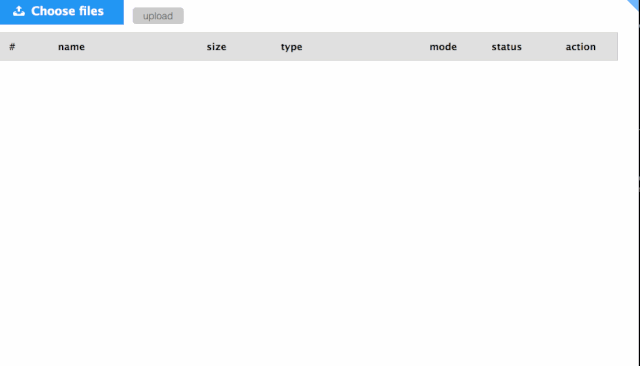Introduction
A simple file transfer web app with support of P2P. Backend is written in Golang, frontend with React.
Features
- P2P file transfer is implemented using simple-filer, a webRTC tool also written by me :smiley:
- upload progress is broadcast to all online users
- page and all its files are auto expired and deleted after specified duration
How to use
I have deployed this app on my server, please go to
https://worksphere.cn/transfer.
You'll be redirected to another page with the URL like this: https://worksphere.cn/transfer/pdhwhwdwny84x1qvzig3xg0z
On this page, you can upload 4 files at most(each file 5M at most), send the page URL to your friends.
You don't need to wait for the upload to finish, then send the URL. Your friends will see the upload progress as you do.
Each page will expire after 20 minutes, after that, all files are removed, and the page URL is no longer valid.
This is a personal site with limited network bandwidth and storage, don't expect too much from the server performance.
However, if you and your friends are both online at he same time, you can try the P2P transfer(Chrome browser only) which copy the file between your browsers without going through server.
The number of files and file size you can transfer in P2P mode is only limited by your computer hard drive.
But P2P connection is not guaranteed to work 100%.
Here is a running screenshot:

Prerequisites
- Go(>= 1.9.2)
- MongoDB(>= 3.2)
- Chrome browser for P2P file transfer
- NodeJS(>=6.5) for client side JavaScript bundling
Build
go get github.com/edwardwohaijun/file-transfer/cmd/filetransferd
cd $GOPATH/src/github.com/edwardwohaijun/file-transfer/
go build -o filetransferd cmd/filetransferd/main.go
cd web
npm install
npm run build (for development environment)
npm run ship (for production environment)
Deployment
- use supervisord: consult init/filetransferd.conf
- manually: just move the
filetransferdbinary andweb/directory(onlypublicsubdirectory is needed) to wherever you seem fit.
The absolute web directory need to be passed as -webRoot argument when run the binary, for example:
filetransferd -webRoot /var/www/filetransferd/web
command arguments(case matters)
serverPortdefault is9090.mgoHostmongoDB host IP and port, default is127.0.0.1:27017.mgoUsernamemongoDB username, default is empty.mgoPasswordmongoDB password, default is empty.mgoDBNamemongoDB database name, default isfiletransfer.mgoCollectionNamemongoDB collection name, default isfiles.maxUploadthe maximum allowed number of upload files for one page, default is 5.maxFileSizethe maximum allowed single filesize, default is 20M, only allowed unit ismegabyte,10m,20Mare all valid.durationhow long uploaded files exist on server, default is 30m, allowed units are: m(minute), h(hour), d(day).urlRootPaththe path following your domain(or IP), for example:transferin http://www.example.com/transfer, default is empty.webRootthe directory to serve web static files, default iswebin current working directory.uploadDirthe directory to save the uploaded files, default isupload, relative directory is assumed to be inside current working directory.webrtcConfigthe iceServer list to help both parties make P2P connection, you need to pass the argument in quoted JSON string, default is empty.
Examples:
filetransferd -serverPort 9090 -maxUpload 5 -maxFileSize 20M -duration 30m -urlRootPath abc/xyz/ -webRoot ./web -uploadDir ./upload
-webrtcConfig '{"iceServers":[{"urls":"stun:stun.l.google.com:19302"},{"urls":"stun:global.stun.twilio.com:3478?transport=udp"}]}'
Go to http://127.0.0.1:9090/abc/xyz/, if you want to experience the P2P file transfer, open 2 tabs.
You can run multiple app instances, as long as they have different serverPort.
If you have Nginx(>= 1.7.11) running in front, let it handle the webRoot directory for better performance.
Copy the web/public folder to where Nginx can access (like /var/www/webApp/transfer/), and edit Nginx config file, like the following:
# in server block
location /transfer/public {
alias /var/www/webApp/transfer/web/public/;
}
location /transfer {
proxy_pass http://127.0.0.1:9090;
proxy_request_buffering off;
proxy_redirect off;
proxy_set_header Upgrade $http_upgrade;
proxy_set_header Connection "upgrade";
proxy_set_header Host $http_host;
proxy_set_header X-Real-IP $remote_addr;
proxy_set_header X-Forwarded-For $proxy_add_x_forwarded_for;
proxy_set_header X-Forwarded_Proto $scheme;
}
The P2P feature works pretty well in small office and local network, you can adjust the maxUpload, maxFileSize to meet your needs.
It only takes you less than 2 minutes to go get the code, build, deploy the web app, :stuck_out_tongue_winking_eye:.
License
This project is licensed under the MIT License.